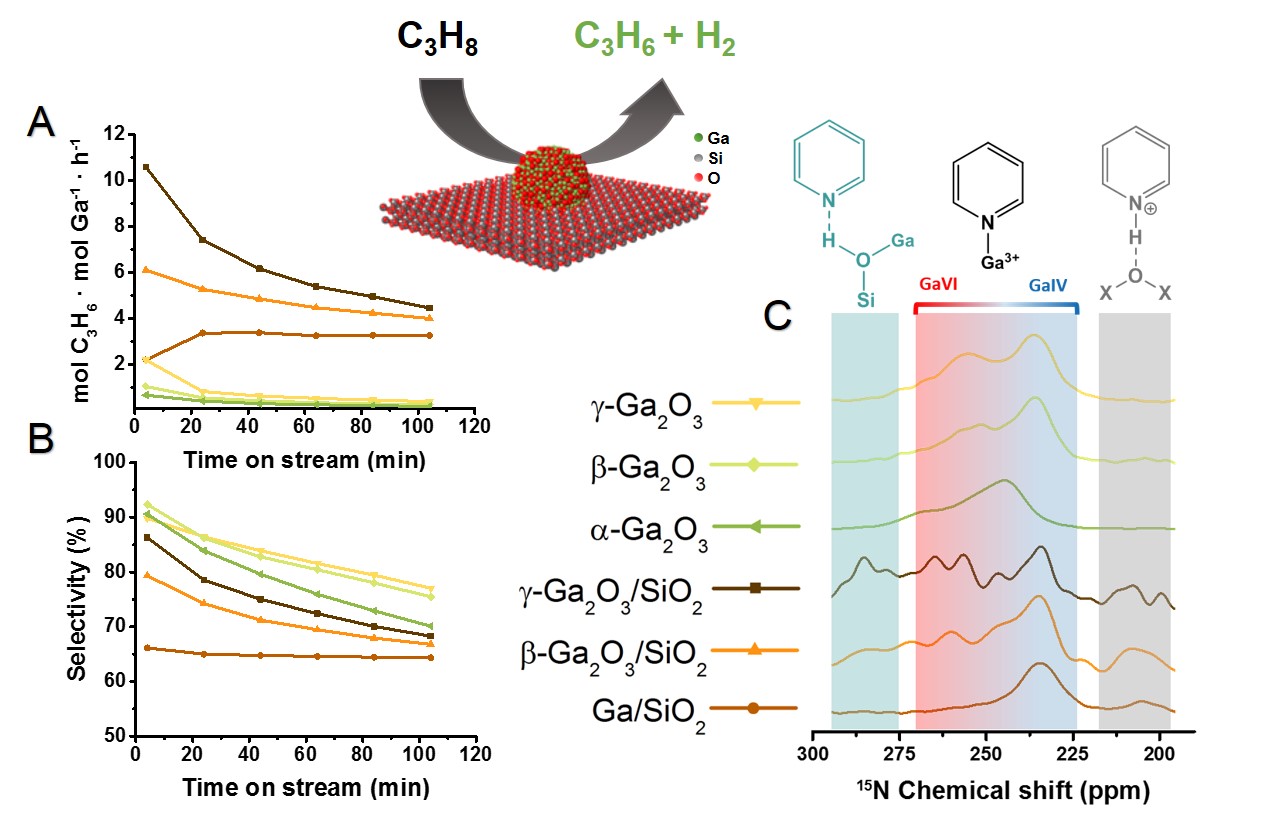Understanding the Nature of Surface Sites in Ga2O3‑Based Catalysts for Propane Dehydrogenation: Acidity, Deactivation, and the Support Effect
Ga2O3-based catalysts for the dehydrogenation of propane (PDH) feature hexa- and tetracoordinated Ga3+ sites, the latter are likely the active centers for PDH.[1] However, little is known about the distribution and nature of surface sites in Ga2O3-based PDH catalysts and the influence of surface acidity, structural defects and the support on the catalytic activity. Here, we report that the specific activity of silica-supported γ–Ga2O3 nanoparticles (γ–Ga2O3/SiO2) in PDH is higher than that of β–Ga2O3/SiO2 and a Ga(NO3)3-derived benchmark, Ga/SiO2. We characterized surface sites by pyridine-FTIR and 15N DNP NMR and developed structure-activity relationships for this class of catalysts. γ–Ga2O3/SiO2 is a more active but less selective catalyst than unsupported γ–Ga2O3 (Fig. 1, A, B). Surface acidity studies reveal mild Brønsted acid sites only for γ–Ga2O3/SiO2. Such sites likely result from the interaction between γ–Ga2O3 and SiO2 and may be associated with the high specific activity and lower selectivity of γ–Ga2O3/SiO2. The defect-spinel structure of γ–Ga2O3 contains structural vacancies susceptible to cationic substitutions,[2] which could promote an interaction with the silica support, thus yielding mild Brønsted acidity with distinct catalytic performance. Interactions between Lewis acid sites and surface silanol groups generating Brønsted acidic sites have been described for zeolites and silica-aluminas,[3,4] but to our knowledge, they have not yet been characterized for interfacial sites in SiO2-supported metal-oxide nanoparticles. In contrast to all other catalysts in this work, Ga/SiO2, the benchmark featuring only tetracoordinated Ga sites, does not deposit any coke and does not deactivate on stream. 15N DNP NMR spectra (Fig. 1C) show features at ca. 235 ppm ascribed to Ga(IV) sites for all catalysts except α–Ga2O3. This suggests that higher-coordinated Ga sites could be associated with coke-related deactivation in PDH. Overall, we establish structure-activity relationships for Ga2O3-based PDH catalysts by elucidating the surface sites of silica-supported and unsupported polymorphs of Ga2O3, also providing insight for the interaction between γ–Ga2O3 and the silica support.

Figure 1. PDH specific activity (A) and selectivity (B) for Ga2O3 catalysts. 15N DNP NMR results, relating features at different chemical shifts with the pyridine-bound surface Ga sites (C).
[1] Fan, K.N., et al., J. Catal., 2008, 256, 293–300.
[2] Gupta, P, et al., J. Phys. Chem. C., 2018, 122, 22094−22105.
[3] Meriaudeau, P., et al., J. Mol. Catal., 1990, 59, L31 - L36.
[4] Hensen, J. M., et al., J Phys. Chem. C., 2012, 116, 21416–21429.